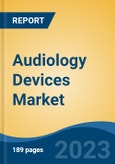Speak directly to the analyst to clarify any post sales queries you may have.
10% Free customizationThis report comes with 10% free customization, enabling you to add data that meets your specific business needs.
The market encompasses a wide range of medical devices designed to diagnose, treat, and manage hearing-related conditions - from mild hearing loss to profound deafness. Key product categories include hearing aids, cochlear implants, bone-anchored hearing systems, and assistive listening devices. These solutions significantly enhance quality of life by enabling individuals with hearing impairments to engage more fully in social, educational, and professional settings.
Key Market Drivers
Rising Incidence of Noise-Induced Hearing Loss (NIHL)
Hearing loss has emerged as a significant global health concern, impacting millions of individuals worldwide. Among the various causes, noise-induced hearing loss (NIHL) has gained prominence due to increasing exposure to high-decibel environments. This preventable form of hearing impairment is accelerating demand for audiology devices.NIHL is typically caused by prolonged exposure to loud sounds - such as those from industrial machinery, construction equipment, live concerts, and high-volume personal audio devices. As urbanization and industrialization expand, so does the risk of auditory damage in both occupational and recreational settings. Young adults are particularly vulnerable, with the World Health Organization (WHO) estimating that over 1 billion individuals aged 12 to 35 are at risk of permanent hearing loss due to unsafe listening habits.
This growing prevalence of NIHL underscores the need for preventive care, early detection, and effective treatment - further driving demand for advanced audiology devices.
Key Market Challenges
Accessibility and Affordability
One of the primary barriers to widespread adoption of audiology devices is their cost and limited accessibility, particularly in low- and middle-income regions. Hearing aids, cochlear implants, and related devices can be prohibitively expensive for many individuals, resulting in unequal access to hearing healthcare services.This affordability gap has prompted intervention by governments, non-profit organizations, and healthcare providers to improve access. Initiatives such as subsidies, insurance coverage, and financial aid programs are being implemented to help offset the cost burden on patients. Simultaneously, advancements in manufacturing technologies are contributing to lower production costs, which may help reduce prices and increase affordability over time.
Despite these efforts, bridging the affordability divide remains a critical challenge to expanding the global reach of audiology solutions.
Key Market Trends
Technological Innovation Driving Market Growth
Technological advancement continues to be a major catalyst for growth in the audiology devices market. As hearing-related conditions become more prevalent - driven by aging populations and rising noise pollution - there is a growing demand for innovative, high-performance solutions.A key innovation shaping the industry is the integration of Digital Signal Processing (DSP) and Artificial Intelligence (AI) into audiology devices. DSP enables devices to deliver more natural and precise sound quality, while AI allows real-time adaptation to various auditory environments. These features improve speech clarity and reduce background noise, offering users a significantly enhanced listening experience.
Modern audiology devices also offer seamless wireless connectivity with smartphones and other digital platforms. Users can stream audio directly to their hearing aids, personalize settings via mobile applications, and even receive remote support from audiologists. This level of connectivity has elevated both convenience and user engagement.
In parallel, miniaturization and ergonomic design have made hearing aids more discreet and comfortable to wear, reducing the stigma often associated with device usage and promoting broader acceptance.
The adoption of telehealth and remote monitoring capabilities has also accelerated, particularly in response to the COVID-19 pandemic. These capabilities enable patients to receive consultations, device adjustments, and follow-up care remotely - minimizing the need for in-person visits and expanding access to care, especially in underserved areas.
In sum, the audiology devices market is undergoing a profound transformation. Technological advancements have not only improved device performance but also increased usability, accessibility, and overall quality of care. With continued innovation and growing global demand, the audiology industry is well-positioned for sustained growth and long-term impact.
Key Market Players
- Demant A/S
- GN Store Nord A/S
- Sonova Holding AG
- Starkey Laboratories, Inc.
- MED-EL Medical Electronics
- Cochlear Ltd.
- WS Audiology A/S
- MAICO Diagnostics GmbH
- Oticon Medical Ab
- INVENTIS srl
Report Scope:
In this report, the Global Audiology Devices Market has been segmented into the following categories, in addition to the industry trends which have also been detailed below:Audiology Devices Market, By Technology:
- Digital
- Analog
Audiology Devices Market, By Product:
- Cochlear Implants
- Hearing Aids
Audiology Devices Market, By Sales Channel:
- Retail Stores
- Government Purchases
- E-Commerce
Audiology Devices Market, By Region:
- North America
- United States
- Canada
- Mexico
- Europe
- France
- United Kingdom
- Italy
- Germany
- Spain
- Asia-Pacific
- China
- India
- Japan
- Australia
- South Korea
- South America
- Brazil
- Argentina
- Colombia
- Middle East & Africa
- South Africa
- Saudi Arabia
- UAE
Competitive Landscape
Company Profiles: Detailed analysis of the major companies present in the Global Audiology Devices Market.Available Customizations:
With the given market data, the publisher offers customizations according to a company's specific needs. The following customization options are available for the report.Company Information
- Detailed analysis and profiling of additional market players (up to five).
This product will be delivered within 1-3 business days.
Table of Contents
Companies Mentioned
- Demant A/S
- GN Store Nord A/S
- Sonova Holding AG
- Starkey Laboratories, Inc.
- MED-EL Medical Electronics
- Cochlear Ltd.
- WS Audiology A/S
- MAICO Diagnostics GmbH
- Oticon Medical Ab
- INVENTIS srl
Table Information
| Report Attribute | Details |
|---|---|
| No. of Pages | 182 |
| Published | April 2025 |
| Forecast Period | 2024 - 2030 |
| Estimated Market Value ( USD | $ 10.53 Billion |
| Forecasted Market Value ( USD | $ 15.58 Billion |
| Compound Annual Growth Rate | 6.7% |
| Regions Covered | Global |
| No. of Companies Mentioned | 10 |









